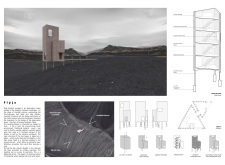5 key facts about this project
The tower features a minimalist design characterized by geometric shapes, elevated on slender concrete pilings. The structure minimizes ecological impact and enhances visual access to the unique geological features of the region. The primary materials used include wooden cladding, plywood floor panels, and concrete, which collectively contribute to a warm aesthetic while ensuring structural integrity.
Unique Design Approaches
Flýja distinguishes itself through several innovative design strategies. The structure is organized into multiple viewing platforms, each offering differing perspectives of the landscape. This vertical arrangement encourages exploration and interaction, allowing visitors to engage with the environment actively as they ascend the tower. Natural light floods the interior through well-placed openings, creating a dynamic atmosphere that shifts throughout the day.
The spiral staircase serves as an essential element, guiding users through the building while framing views of the volcanic surroundings. The thoughtful integration of the tower with its landscape allows for a 'floating' appearance, enhancing the visual relationship between the built structure and its natural setting.
Spatial Organization
The interior layout emphasizes fluid circulation, promoting an intuitive flow for visitors. Each level is designed to provide unobstructed views, supporting the primary goal of the project: to immerse individuals in the natural beauty of Icelandic geography. The design underscores environmental consciousness through the choice of materials and the minimal footprint of the structure, further enhancing its harmony with the landscape.
The architectural plans, sections, and designs of Flýja illustrate a commitment to merging form with function in response to its context. The project showcases approaches that respect the landscape while providing a space for reflection and connection to the natural world. For a more in-depth exploration of this project, including architectural plans and sections, readers are encouraged to delve into the specific details of Flýja's design.























